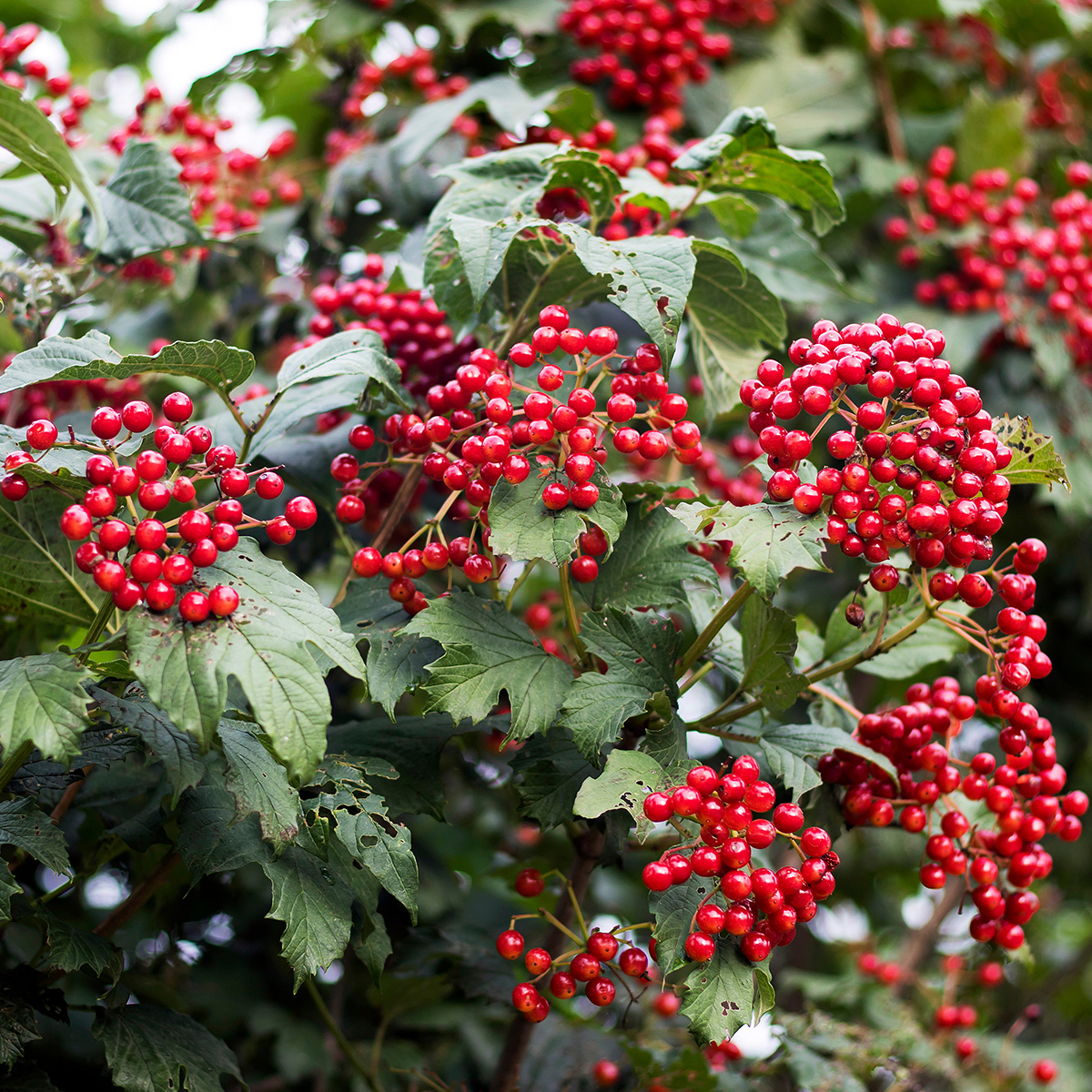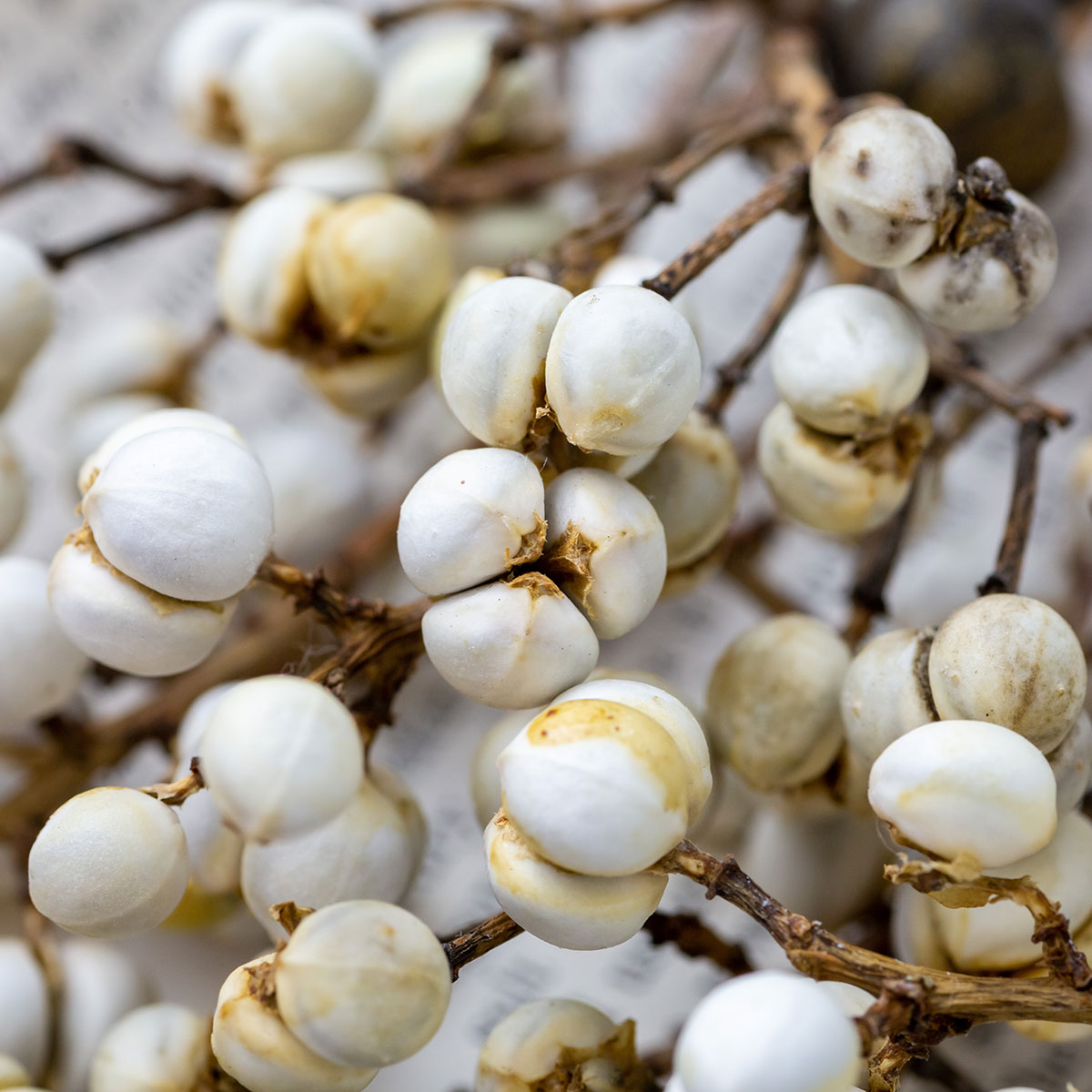Completing our 2023 lookbook series, our sixth and final trend, ATMOSPHERIC, pays homage to our planet's habitats at large. This trending macro view gathers an immersive palette of cool hues, borrowed from the oceans and forests, and pairs it with glowing bright white.
Our Essential Guide to Decorative Winter Berries (Plus A Few Imposters That Are Dead Ringers)
'Tis the season for winter florals. Time and time again, shrub berries—and "berry-like" cut flowers—have proved to make an excellent pairing with other seasonal varieties in traditional holiday tones. They not only provide contrast and freshness to an array of recipes, but also engage the senses with their colors, textures, fragrances and flavor—yes, many are edible!
Keep reading for a list of our favorite winter berries (and a few impersonators) that will help enliven decorating projects for the season ahead.
AMERICAN HOLLY. Deck the halls with boughs of holly! American holly, Ilex opacca, is arguably one of the most recognizable (and beloved) symbols of Christmas and the winter season. Once regarded as sacred in ancient Greece and Rome, this evergreen shrub featuring distinctively spiny, deep green foliage and bright red berries has become a time-tested staple of yuletide traditions. Symbolizing hospitality, goodwill and good fortune, holly is typically seen on wreaths, garlands, ornaments and other holiday decor.
WINTERBERRY. Featuring long, slender branches draped with small—yet abundant—clusters of brilliant red berries, winterberry (Ilex verticillata) offers considerable impact and visual interest to winter landscapes and floral decor. Although a cousin of American holly, winterberry shrubs are not evergreen (they are deciduous), nor is their foliage shaped with "sharp teeth" like other holly varieties.
HYPERICUM. More than a foliage filler, yet not quite a flower, Hypericum offers the unexpected texture of ripe berries amid star-shaped flowers, dense leaves and woody branches. Modern cultivars used year-round can range in foliage color and in the size and tone of their berries (which include red, orange, peach, yellow, green and white hues). In floral decorations for winter, Hypericum stems in classic red, white and green shades add depth and festive texture to holiday bouquets and arrangements.
VIBURNUM BERRY. With over 150 species of evergreen and deciduous shrubs, the Viburnum genus is as diverse as it is vast. The most common species, Viburnum opulus, is known for its showy display of creamy-white (or sometimes pink) flowers, maple-like foliage and scarlet red berries that resemble cranberries. These berries—which also come in pink, yellow, blue and deep purple to black shades—are edible and were used by early U.S. settlers and Native Americans as a nutritious food source.
NANDINA BERRY. The berries of this Asian native may look good enough to eat, but be warned—they are poisonous! Also known as sacred or heavenly bamboo, Nandina (Nandina domestica) is an evergreen shrub that produces spring flowers, lightly branched and cane-like stems, and delicate, broadleaf foliage. Its shiny-red berries are similar to those of holly and retain most of their brilliant color throughout the winter.
ROSE HIPS. When rose blooms fade at the end of the season, they leave behind a botanical wonder. Rose hips, which include the berry-sized fruit (or seed pods) of rose plants, grow after the flower petals have fallen off. These are usually red or orange in color, but may also be purple or black. And beyond their ornamental uses in winter florals, rose hips have acquired special attention for their applications in health and beauty remedies. They are especially rich in Vitamin C, antioxidants and other disease-fighting agents.
BEAUTYBERRY. This unique deciduous shrub was named after its most striking feature: its berries. The genus of Callicarpa americana comes from a combination of the Green words “callos” (beauty) and “carpos” (fruit)—hence the common name, beautyberry. Typically appearing in late summer, these iridescent purple/magenta (or sometimes white) berries surround beautyberry's long, arching branches and persist throughout the winter. They not only offer visual interest but also make an important food source for wildlife.
SNOWBERRY. True to its namesake, common snowberry (Symphoricarpos albus) was named after—you guessed it—its snow-white berries. In the spring, this ornamental shrub produces dense clusters of white or pink, bell-shaped florets that get replaced by berry bunches in the fall. These last well into winter and offer a lovely display among the shrub's leafless branches at the end of the season.
PRIVET BERRY. Common privet (Ligustrum vulgare) is a fast-growing, deciduous or semi-evergreen shrub that features attractive, dark green foliage and white, honey-scented flowers that bloom in late spring. In the fall, these blooms give way to small, glossy berries that ripen to black and last throughout the winter season. And although privet berries make a great meal for birds, humans and four-legged friends should steer clear: they are toxic and can cause a host of unpleasant side effects when eaten.
UNRIPE BLACKBERRIES. Who knew that this incredibly nutritious (and delicious) snack also makes a fabulous floral filler? The only caveat: use the fruits before they ripen to prevent a messy setup or display. Unripe blackberries come in an array of colors—including dark pink, purple and green—and when combined with other blooms in seasonal shades, these lend an elegant touch to winter arrangements and bouquets.
TALLOW BERRY. Tallow berries make a lovely addition to holiday florals and decor. Also known as Chinese tallow tree or popcorn tree, the tallow tree (Triadica sebifera) grows up to 40 feet in height and features white berries that grow atop freely-branched stems. These berries, which appear in autumn, turn brown when mature. Here, they reveal three dull, white seeds that resemble popcorn in shape—hence the common name.
BRUNIA BERRY. Brunia berries aren't berries at all—they are actually ball-shaped flowers! Native to South Africa, Brunia albiflora is an evergreen shrub that is cultivated as a cut flower; its colors typically range from silver to green to red. Brunia's claim to fame is its novel, pine-like foliage and spherical flowering heads that are covered by scale-like leaves. An excellent filler, Brunia adds intense texture and natural, neutral shades (like gray) that are generally hard to find among other cut flower varieties.
PEPPERBERRY. A long-lasting and fragrant addition to winter arrangements, pink pepperberries grow freely atop the willow-like branches of large, evergreen trees (Schinus molle) in the fall and winter. These are often sold as a peppercorn spice, like the ones seen in grocery stores, but they have no physical relation to commercial pepper. Boasting seasonal colors, cascading characteristics and a slightly peppery aroma, pink pepperberries also make prized fillers for adding volume and contrast to seasonal displays.
BERZELIA BERRY. Another berry imposter on this list, Berzelia (Berzelia lanuginosa) "berries" are actually flowering heads. The genus consists of 12 species of evergreen shrubs that feature a dense covering of fine, needle-like leaves that are almost feathery in appearance and texture. Topping its slender branches are small, white flowers that are arranged into round, umbel-like clusters; when they are young, the flower heads are usually lime-green in color. As they ripen, they change to maroon-red.
BERRIED IVY (HEDERA HELIX). Also referred to as common or English ivy, Hedera helix is native to most of Europe and Western Asia. This hardy, evergreen vine grows rampantly in wild areas, gardens, tree trunks and the like. Especially popular as an ornamental plant, berried ivy features dark green, glossy foliage and produces umbrella-like groups of small, yellow-green flowers in the fall—followed by dark purple to black berries in the late winter or early spring.
JUNIPER BERRY. The Juniper tree (Juniperus communis) is an evergreen species that varies in size and shape, from small, low-spreading shrubs to tall trees. It produces needle-like (or scale-like) foliage accented by fleshy seed cones—known as juniper “berries”—that are mostly deep blue in color, but can also be found in red-brown or orange shades. And although their common name implies otherwise, these “berries” are not technically berries; they just look like them. They also have a tart, pine-like flavor, a peppery scent, and are high in nutrients. It's not surprising, then, that different parts of juniper plants have been used in culinary and medicinal recipes throughout history.
POKEBERRY. American pokeweed (Phytolacca americana) is as useful as it is beautiful! A perennial herb celebrated for its medicinal and tactical properties, pokeweed produces bright, lance-shaped foliage and flowers born in linear clusters on short, magenta-hued stems. When the flowers wither, green berries appear and ripen to almost black. Each pokeberry has 10 seeds with an outer coating that is so hard, the seeds can remain viable for 40 years! Pokeberry juice has also been used as an ingredient in early dye and ink recipes; legend has it that the Declaration of Independence may have been drafted in pokeberry ink.
HAWTHORN BERRY. A member of the Crataegus genus, hawthorn varieties include a number of trees and shrubs that are relatives of the rose family. These deciduous types are mostly cultivated for ornamental reasons, due to their attractive foliage, fragrant pink (or white) flowers, and edible berries. Similar in appearance to rose hips, these fruits—which are usually dark red, orange, yellow or black in color—are packed with nutrition and may vary in flavor and texture.
JAPANESE SKIMMIA. Native to Japan, China and Southeast Asia, Japanese Skimmia (Skimmia japonica) is a small, dense evergreen shrub that produces dome-shaped clusters of fragrant, star-shaped florets in the summer; these are usually white but are also found in pink shades. If they are pollinated, only female shrubs will develop bright red berries throughout the fall and winter. These vibrant fruits contrast beautifully with the plant's rich, dark green leaves that emit a pleasing aroma when crushed.
CHINABERRY. Commonly referred to as China Tree and Pride of India, Chinaberry (Melia azedarach) is an ornamental deciduous tree that readily grows in prairies, fields and along roadsides. A member of the mahogany family, its stems vary in color—from olive green and brown to purplish-red—and produce tubular flowers in pale purple to pink shades. These blooms are fragrant and emit an aroma similar to that of southern magnolia trees. Its branches are also topped with clusters of round, green to yellow-tan berries that will persist throughout the winter. Although they are poisonous when consumed, Chinaberries can be dried, dyed and made into beads for use in jewelry.






























